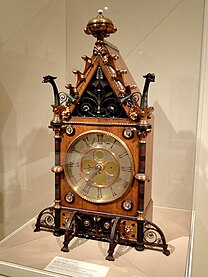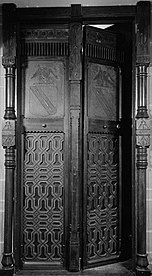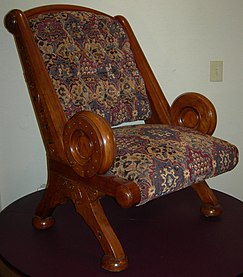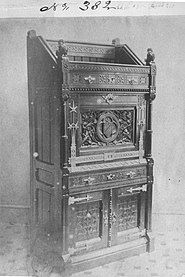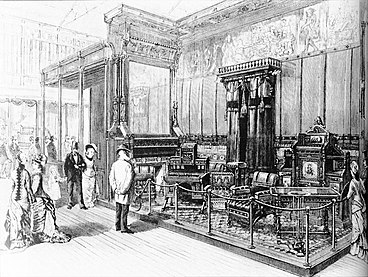
Eugène Emmanuel Viollet-le-Duc was a French architect and author, famous for his restoration of the most prominent medieval landmarks in France. His major restoration projects included Notre-Dame de Paris, the Basilica of Saint Denis, Mont Saint-Michel, Sainte-Chapelle, the medieval walls of the city of Carcassonne, and Roquetaillade castle in the Bordeaux region.

Furniture refers to objects intended to support various human activities such as seating, eating (tables), storing items, working, and sleeping. Furniture is also used to hold objects at a convenient height for work, or to store things. Furniture can be a product of design and can be considered a form of decorative art. In addition to furniture's functional role, it can serve a symbolic or religious purpose. It can be made from a vast multitude of materials, including metal, plastic, and wood. Furniture can be made using a variety of woodworking joints which often reflects the local culture.
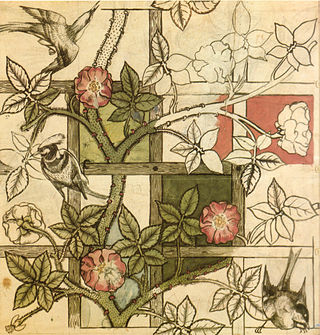
The Arts and Crafts movement was an international trend in the decorative and fine arts that developed earliest and most fully in the British Isles and subsequently spread across the British Empire and to the rest of Europe and America.

Frank Heyling Furness was an American architect of the Victorian era. He designed more than 600 buildings, most in the Philadelphia area, and is remembered for his diverse, muscular, often inordinately scaled buildings, and for his influence on the Chicago-based architect Louis Sullivan. Furness also received a Medal of Honor for bravery during the Civil War.
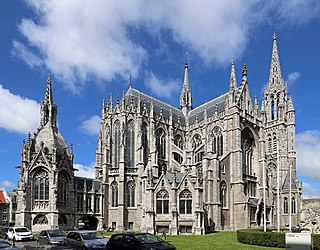
Gothic Revival is an architectural movement that after a gradual build-up beginning in the second half of the 17th century became a widespread movement in the first half of the 19th century, mostly in England. Increasingly serious and learned admirers sought to revive medieval Gothic architecture, intending to complement or even supersede the neoclassical styles prevalent at the time. Gothic Revival draws upon features of medieval examples, including decorative patterns, finials, lancet windows, and hood moulds. By the middle of the 19th century, Gothic Revival had become the pre-eminent architectural style in the Western world, only to begin to fall out of fashion in the 1880s and early 1890s.

Néo-Grec was a Neoclassical Revival style of the mid-to-late 19th century that was popularized in architecture, the decorative arts, and in painting during France's Second Empire, the reign of Napoleon III (1852–1870). The Néo-Grec vogue took as its starting point the earlier expressions of the Neoclassical style inspired by 18th-century excavations at Pompeii, which resumed in earnest in 1848, and similar excavations at Herculaneum. The style mixed elements of the Graeco-Roman, Pompeian, Adam and Egyptian Revival styles into "a richly eclectic polychrome mélange." "The style enjoyed a vogue in the United States, and had a short-lived impact on interior design in England and elsewhere."

Edward William Godwin was a progressive English architect-designer, who began his career working in the strongly polychromatic "Ruskinian Gothic" style of mid-Victorian Britain, inspired by The Stones of Venice, then moved on to provide designs in the "Anglo-Japanese taste" of the Aesthetic movement in the 1870s, after coming into contact with Japanese culture in the 1862 International Exhibition in London. Godwin's influence can be detected in the later Arts and Crafts movement.

William Burges was an English architect and designer. Among the greatest of the Victorian art-architects, he sought in his work to escape from both nineteenth-century industrialisation and the Neoclassical architectural style and re-establish the architectural and social values of a utopian medieval England. Burges stands within the tradition of the Gothic Revival, his works echoing those of the Pre-Raphaelites and heralding those of the Arts and Crafts movement.
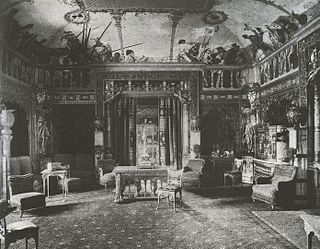
The firm of Herter Brothers,, was founded by German immigrants Gustave (1830–1898) and Christian Herter (1839–1883) in New York City. It began as a furniture and upholstery shop/warehouse, but after the Civil War became one of the first American firms to provide complete interior decoration services. With their own design office and cabinet-making and upholstery workshops, Herter Brothers could provide every aspect of interior furnishing—including decorative paneling, mantels, wall and ceiling decoration, patterned floors, carpets and draperies.

Victorian decorative arts refers to the style of decorative arts during the Victorian era. Victorian design is widely viewed as having indulged in a grand excess of ornament. The Victorian era is known for its interpretation and eclectic revival of historic styles mixed with the introduction of Asian and Middle Eastern influences in furniture, fittings, and interior decoration. The Arts and Crafts movement, the aesthetic movement, Anglo-Japanese style, and Art Nouveau style have their beginnings in the late Victorian era and gothic period.
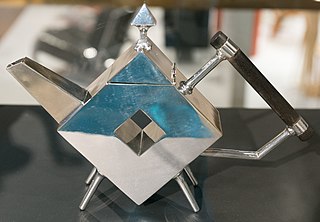
The Anglo-Japanese style developed in the United Kingdom through the Victorian era and early Edwardian era from approximately 1851 to the 1910s, when a new appreciation for Japanese design and culture influenced how designers and craftspeople made British art, especially the decorative arts and architecture of England, covering a vast array of art objects including ceramics, furniture and interior design. Important centres for design included London and Glasgow.

Daniel Pabst was a German-born American cabinetmaker of the Victorian Era. He is credited with some of the most extraordinary custom interiors and hand-crafted furniture in the United States. Sometimes working in collaboration with architect Frank Furness (1839–1912), he made pieces in the Renaissance Revival, Neo-Grec, Modern Gothic, and Colonial Revival styles. Examples of his work are in the collections of the Metropolitan Museum of Art, the Philadelphia Museum of Art, the Art Institute of Chicago, and the Victoria and Albert Museum in London.
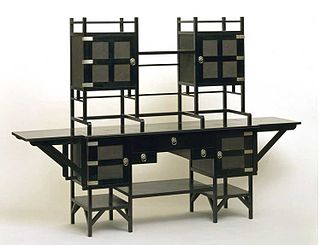
This sideboard was designed by Edward William Godwin (1833–1886), who was one of the most important exponents of Victorian Japonisme or Anglo-Japanese style, the appropriation of Japanese artistic styles.

The Provident Life & Trust Company is a demolished Victorian-era building in Philadelphia designed by architect Frank Furness and considered to be one of the famed architect's greatest works. A bank and insurance company founded in 1865 by members of the Society of Friends (Quakers), the Provident's L-shaped building had entrances at 407–09 Chestnut Street, which served as the entrance to the bank, and at 42 South 4th Street, which was the entrance to the insurance company. The two wings were eventually consolidated into an office building, also designed by Furness, at the northwest corner of 4th and Chestnut Streets.

Joseph Alexis Bailly was an American sculptor who spent most of his career in Philadelphia, Pennsylvania. He taught briefly at the Pennsylvania Academy of the Fine Arts, which has a collection of his sculpture. His most famous work is the statue of George Washington in front of Independence Hall.
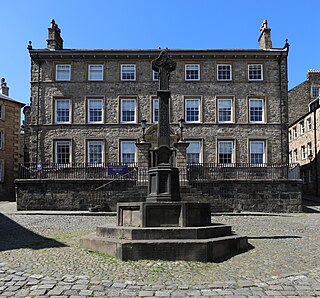
The Judges' Lodgings, formerly a town house and now a museum, is located between Church Street and Castle Hill, Lancaster, Lancashire, England. It is recorded in the National Heritage List for England as a designated Grade I listed building. The building is the oldest existing town house in Lancaster, and was also the first house in Lancaster to have shutters. It was used by judges when they attended the sessions of the Assize Court.

Kimbel & Cabus was a Victorian-era furniture and decorative arts firm based in New York City. The partnership was formed in 1862 between German-born cabinetmaker Anthony Kimbel and French-born cabinetmaker Joseph Cabus (1824–1894). The company was noted for its Modern Gothic and Anglo-Japanese style furniture, which it popularized at the 1876 Centennial Exposition.

Bruce James Talbert was a Scottish architect, interior designer and author, best known for his furniture designs.
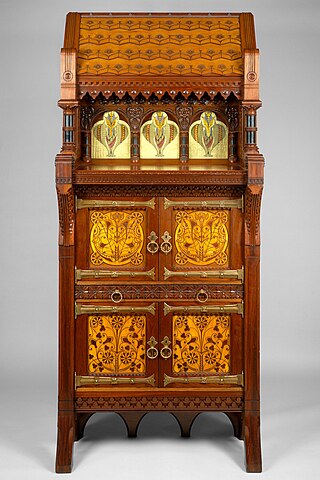
Modern Gothic exhibition cabinet is a piece of Modern Gothic furniture now in the collection of the Metropolitan Museum of Art. Although its design was once attributed to Philadelphia architect Frank Furness and furniture maker Daniel Pabst, MMA now credits its design and manufacture to Pabst alone. At 8 feet (2.4 m) tall, it is an unusually large and polychromatic American example of the rare style.

Thomas Jeckyll was an English architect who excelled in the creation of metalwork and furniture strongly influenced by Japanese design, and is best known for his planning in 1876 of the ‘Peacock Room’ at 49 Princes Gate, London.


